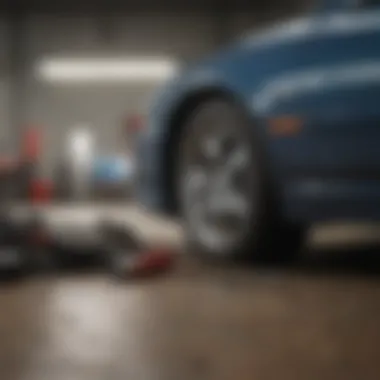Collision Repair Financing Options: A Complete Guide


Intro
In today's automotive landscape, collision repair is a crucial topic for vehicle owners. Car accidents happen, and the aftermath often requires significant repairs to maintain both functionality and aesthetics. Addressing these damages is not merely about keeping the vehicle running; it is about ensuring the safety and integrity of the owner and passengers. However, the cost associated with these repairs can be daunting. This is where financing options become a pivotal consideration.
Understanding the relationship between collision repair services and financing can empower vehicle owners to make better decisions. As the repairs can often lead to unexpected expenses, being informed about the available financing methods can ease the financial burden. This guide aims to illuminate the various financing options available for collision repair, disparate types of coverage, and vital considerations for vehicle owners. Furthermore, it delves into how auto insurance claims fit into this equation, offering practical strategies to manage repair costs effectively.
Understanding Collision Repair
Understanding collision repair is crucial for vehicle owners who wish to maintain the integrity and functionality of their automobiles. This topic encompasses various facets of managing vehicle damages due to accidents, including the repair processes and associated costs. Furthermore, knowledge in this area empowers individuals to make informed decisions regarding repair options and financing methods.
Definition and Importance
Collision repair refers to the process of restoring a vehicle that has sustained damage from an accident. This may include fixing dents, replacing parts, and ensuring that the vehicle meets safety standards. Importance lies in the fact that timely and effective repairs can prevent further deterioration of the vehicle, enhance resale value, and provide safety for the occupants.
Common Types of Collision Damages
Generally, collision damages can be categorized into several types. Common examples include:
- Body Damage: Dents and scratches that affect the exterior appearance.
- Frame Damage: Structural issues that compromise the vehicle’s integrity.
- Paint Damage: Chipped or scratched paint that may lead to rusting.
- Mechanical Damage: Damages affecting crucial components such as the engine or transmission.
Understanding these types is essential, as it helps vehicle owners communicate effectively with repair shops and enables them to address any concerns about their vehicle’s condition.
Repair Process Overview
The repair process can be broken down into several key steps that facilitate an effective restoration of a vehicle.
Assessment of Vehicle Damage
Assessment of vehicle damage is the initial step in collision repair. Technicians evaluate the extent of the damage to give an accurate depiction of what repairs are needed. This aspect is critical because it sets the stage for both the repair work and cost estimates. A defining characteristic of this process is the thorough inspection conducted by a qualified technician. This not only identifies major damages but also points out less obvious issues that could lead to future problems. The advantage is that it allows for comprehensive repairs rather than just cosmetic fixes, leading to greater safety and longevity of the vehicle.
Estimating Repair Costs
Estimating repair costs involves calculating the financial implications of the necessary repairs based on the assessment. This crucial step helps vehicle owners understand the financial commitment needed for restoration. A significant characteristic of this process is its reliance on labor and parts prices. By providing a detailed breakdown, repair shops can ensure transparency with customers. The challenge, however, is that unexpected damages may arise during repairs, which can lead to cost overruns. Nevertheless, having an initial estimate helps in budgeting and ensures that owners are prepared before committing.
Repair Techniques
Repair techniques encompass the methods used to restore the vehicle to its pre-accident condition. These may include traditional bodywork, paintless dent repair, and structural realignment. The advantage of utilizing advanced repair techniques is that they may result in a quicker turnaround time and sometimes better outcomes. However, each technique varies in costs, effectiveness, and availability, depending on the shop and type of damage. Understanding these nuances assists vehicle owners in making choices that align with their expectations and financial capabilities.
The Financial Aspect of Collision Repair
Understanding the financial ramifications of collision repair is critical for vehicle owners. The costs associated with repairing a vehicle can vary tremendously depending on many factors, including the extent of the damage and the chosen repair shop. By gaining a comprehensive understanding of these financial aspects, owners can make informed decisions that align their repair choices with their financial capabilities.
Cost breakdowns, insurance matters, and other financial considerations play a significant role. Being informed about these topics can help reduce surprises and make the repair process smoother.
Cost Breakdown of Collision Repairs
Labor Costs
Labor costs typically represent a significant portion of the total repair expenses. As repair shops often charge by the hour for skilled labor, these rates can vary widely based on the shop's location and expertise. Higher rates might be justified when the shop uses experienced technicians.
The key characteristic of labor costs is that they directly reflect the quality of service provided. Therefore, understanding these costs is essential for owners looking to ensure they receive high-quality repairs. However, opting for lower labor costs might result in inferior work.
Parts Replacement


Parts replacement is another major factor in the financial aspect of collision repairs. Depending on the vehicle make and model, parts can be either relatively inexpensive or exceedingly costly. Original Equipment Manufacturer (OEM) parts are often more expensive than aftermarket alternatives but may offer better compatibility and reliability.
The unique feature of parts replacement lies in the choice between OEM and aftermarket. Vehicle owners must weigh the benefits of using high-quality parts against the potential savings from using cheaper options.
Additional Fees
Additional fees often arise during the repair process. These can include administrative costs, diagnostics fees, or costs associated with environmental waste disposal. While these fees can seem minor compared to labor and parts, they can accumulate and significantly affect the total repair bill.
The key characteristic of additional fees is that they are sometimes unexpected. Being aware of these possible charges ahead of time is important for planning and budget allocation.
Insurance and Collision Repair
Understanding Coverage
Insurance coverage can be a complicated aspect of collision repair, yet it is crucial. Vehicle owners should thoroughly understand their policy details. Different policies offer varying levels of protection, and knowing what is covered can make a big difference in repair costs. For instance, some policies may cover only certain types of damages.
Understanding coverage allows vehicle owners to avoid unexpected out-of-pocket expenses. Knowing the specifics of what your insurance covers can help make the collision repair process less stressful.
Filing Claims
Filing a claim can be an intricate process. Claiming insurance funds involves documenting the damage and communicating with the insurance company about your needs. It’s important to provide clear and accurate information to avoid delays in processing. Inaccuracies can lead to reduced payouts or denial of claims.
Filing claims can also be a beneficial route since it alleviates some financial burden. However, owners need to be prepared for the work involved in substantiating their claims.
Insurance Payouts
Insurance payouts can have a direct impact on the repair process. Once a claim is approved, the insurance company will typically provide funds to cover the repair expenses. However, payouts may not always cover the entire cost. They are determined by the extent of the coverage and the specific damages assessed.
The unique feature of insurance payouts is that they can vary widely. Understanding how these payouts work, along with any potential gaps in coverage, is essential for effective financial planning during collision repairs.
Financing Options for Collision Repair
Understanding financing options for collision repair is essential for vehicle owners. Whether you are facing the aftermath of an accident or a minor collision, the repair costs can be significant. Thus, knowing the financial avenues available ensures you can address your vehicle’s needs without overstraining your budget.
These options often vary in terms of accessibility and terms, impacting not just the immediate cost but also long-term financial health. By exploring these options thoroughly, you empower yourself to make decisions that align with your financial situation and needs.
Out-of-Pocket Payments
Choosing to pay out-of-pocket for collision repairs can be straightforward. When selecting this route, be prepared for the full expense upfront. It gives you control over the repair process and often allows for negotiating better prices with repair shops.
However, this approach requires having sufficient funds available, which may not always be feasible. The selling point is that you can avoid interest charges or long-term obligations that may come with financing. It’s crucial to assess your situation carefully to avoid unnecessary strain on your funds.
Personal Loans
Personal loans are common for managing collision repair costs.
Pros and Cons
Pros of personal loans include their fixed interest rates, which make repayment predictable. They typically offer larger amounts than credit cards, providing flexibility if repairs exceed initial estimates. However, cons can include higher interest rates compared to other methods if you have less-than-stellar credit.
In this case, the debt incurred may take longer to repay, impacting your credit score if missed payments occur. Thus, weighing these factors is critical before committing to a personal loan for repairs.
Application Process


Applying for a personal loan generally involves filling out an application with a lender. This can be done online or in a physical branch. It usually includes providing personal information and proof of income. Once approved, the funds can typically be used almost immediately for necessary repairs.
The significant advantage of this process is speed, allowing quick access to funds that can address immediate repair needs. However, it may also involve a hard inquiry on your credit report, temporarily affecting your credit score.
Credit Card Financing
Using credit cards for financing repairs can be a viable option, especially if you have a card with a significant limit and good rewards.
Interest Rates
Interest rates on credit cards can be among the highest in the market. If you do not pay off the balance within a promotional period, you may face steep penalties. Therefore, this option can be appealing only when there is a plan to pay the balance swiftly, minimizing interest costs.
Benefits and Limitations
The primary benefit of using credit cards is convenience. Many cards offer reward points or cash back for purchases, including repair services. However, the limitation lies in the potential for quick debt accumulation and high-interest charges, emphasizing the need for discipline in repayment.
In-House Financing from Repair Shops
Some repair shops offer in-house financing, allowing customers to pay for repairs over time instead of all at once. This option can help bridge the gap for individuals without immediate funds for larger repairs.
Understanding Terms
Understanding the terms of in-house financing is crucial. This may include interest rates, repayment plans, and any hidden fees that could emerge later. This option can be beneficial due to its flexibility, but it's vital to read the fine print and comprehend the financial commitment.
When to Consider
You might consider in-house financing when the repair costs are significant and immediate payment is not an option. This could also be an attractive consideration if your credit score limits other financing opportunities. However, you should be cautious with this option, ensuring that the overall costs of financing remain manageable in your budget.
Making Informed Decisions
In the context of collision repair, making informed decisions is crucial. Vehicle owners often face emotional and financial stress after an accident. Therefore, knowing the available options can help in navigating the complexities of repairing and financing. Informed decision-making allows vehicle owners to weigh their options carefully, empowering them to choose the best repair solutions without overspending. The insights gained from assessing personal finances, evaluating repair services, and understanding insurance claims significantly contribute to this process. When vehicle owners are knowledgeable about their choices, they reduce uncertainty and can better safeguard their investments.
Determining Your Budget
Assessing Your Financial Situation
Assessing your financial situation is foundational to determining a budget for collision repairs. This involves reviewing income, expenses, and any existing debts. By gaining a clear picture of financial health, one can identify how much money is available to allocate towards repairs. A key characteristic of this assessment is that it illuminates realistic financial limits. This is beneficial as it avoids the pitfalls of overextending finances, which is common during stressful times like after an accident. A unique feature is the ability to foresee future payments if financing options are considered. This situational evaluation can lead to smart choices, although it can feel overwhelming without prior experience.
Setting Repair Priorities
Setting repair priorities is another vital step in the decision-making process. This involves deciding which repairs are absolutely necessary for safety, followed by those that enhance the vehicle’s aesthetic value. The key characteristic here is the prioritization of safety over appearance. This approach is practical because it ensures that the vehicle remains safe to drive while financial resources may be limited. The unique feature of setting priorities is its flexibility; vehicle owners can adjust their plans based on cost estimates. However, one downside may be the difficulty in deciding what repairs should take precedence, which can lead to emotional conflict.
Evaluating Repair Shops
Researching Reviews
Researching reviews of repair shops is essential in ensuring quality service. Customer feedback can reveal a lot about a shop's reputation and reliability. This characteristic is particularly beneficial in a crowded marketplace where choices can be overwhelming. Detailed reviews can provide insights into customer satisfaction and experiences, helping vehicle owners identify trustworthy businesses. The unique feature of researching reviews is the wealth of information available online, though it can also lead to confusion. Not all reviews may be genuine, making critical thinking necessary when analyzing feedback.
Evaluating Quotes
Evaluating quotes from different repair shops helps in understanding the fair market value for repairs. Each quote may vary significantly based on labor, parts, and overhead costs. This characteristic aids vehicle owners in making savings by comparing thorough estimates. A special aspect of quote evaluation is that it forces transparency among repair shops; they must justify their prices to remain competitive. The downside is that it may take time and effort to collect multiple quotes, which is not ideal in urgent situations.
Understanding Warranty Options


Understanding warranty options is crucial in ensuring continued protection for repaired areas of the vehicle. Repair shops often provide various warranty types, which can cover different periods or specific parts. This characteristic is beneficial as it provides peace of mind in case of future issues. A unique feature of warranties is that they can vary greatly between shops, affecting the long-term value of the repairs. However, navigating these options can also be daunting due to the legal jargon often used in warranty agreements.
Navigating Insurance Claims
Documenting Damage
Documenting damage accurately is imperative for any insurance claims related to collision repairs. This could involve taking photographs and collecting witness statements. The importance of this aspect cannot be understated; it serves as crucial evidence when dealing with insurers. A major advantage is that thorough documentation reduces disputes, potentially speeding up the claims process. However, the unique feature is the requirement for meticulous detail, which can be mentally taxing for the vehicle owner post-accident.
Following Up with Insurers
Following up with insurers is a necessary part of ensuring that the claims process moves forward. This involves regularly checking the status of the claim and addressing any queries that arise. A key characteristic of this process is the persistence required; it can take time and patience to receive answers. The benefits of diligent follow-up include prompt resolutions and improved communication with the insurance company. Nevertheless, the downside is that it can feel frustrating and any delays may heighten anxiety levels.
Disputing Low Offers
Disputing low offers from insurance companies is sometimes an unavoidable step in the claims process. Vehicle owners may find initial estimates fall short of the expected repair costs. The importance of this action lies in advocating for fair compensation; it ensures that vehicle owners retain financial support for comprehensive repairs. The advantage is that many insurance companies expect negotiations, which may result in a better offer. However, the unique feature of disputing offers is the potential for escalation; some disputes can take ongoing effort and may lead to stressful negotiations, which is not an ideal position for vehicle owners typically dealing with other related stressors.
Future Considerations
The section on future considerations is critical. It addresses how financial choices in collision repair can have long-term effects. This includes keeping value of the vehicle and safety of driving experience. Vehicle owners must consider how down the line their repairs will impact their resale value. Good financing solutions can help maintain a balance between affordability and preserving the car's worth.
Impact of Financing on Vehicle Value
Financing can significantly affect the overall value of a vehicle. When owners choose to finance repairs, they often consider how much the repairs will increase or decrease the car’s value. If repairs are financed poorly, it may lead to a situation where the loan amount exceeds the vehicle's worth. Conversely, using financing options wisely might enhance the vehicle's condition.
Understanding financing carefully prevents overextending budgets that can lead to future issues, such as difficulty selling the vehicle later.
Preventive Measures for Collision Repairs
Preventive measures play a role in minimizing the need for collision repairs. By addressing small issues early, owners can avoid bigger and costlier problems down the line. This can be seen in both regular maintenance and safe driving techniques.
Regular Maintenance Tips
Regular maintenance is vital. It includes routine tasks like oil changes, tire rotations, and brake inspections. This is crucial for prolonging the lifecycle of a vehicle and preventing major repairs. A well-maintained vehicle often has fewer and less severe collision damages.
Consequently, regular maintenance is a beneficial strategy for vehicle owners as it not only keeps the car running smoothly but also minimizes the financial strain from unexpected repairs.
Driving Safety Techniques
Driving safety techniques ensure the driver and passengers' safety and can help prevent future accidents. This includes understanding the traffic rules, maintaining a safe distance from other cars, and avoiding distractions while driving. Such techniques improve overall safety on the road.
Driving techniques can reduce collision risks significantly. Implementing good practices in daily driving will be beneficial in regards to not only insurance costs but also vehicle longevity.
Emerging Trends in Collision Repair Technology
The field of collision repair is evolving, with technology shaping better practices and solutions. Advantages include faster repairs and improved accuracy in assessments.
Innovative Repair Techniques
Innovative repair techniques change how collisions are dealt with. New methods often reduce the need for extensive work while enhancing results. This can mean quicker turnaround times and lower costs for vehicle owners. As these techniques are adopted widely, they become standard practices that raise the quality of repairs offered.
The uniqueness of these innovations lies in their ability to match original specifications more accurately, thus maintaining the car's value.
The Role of AI in Collision Assessment
Artificial Intelligence (AI) is becoming prominent in collision assessments. It brings improved efficiency and precision when evaluating vehicle damage. AI systems can analyze photos or assessments quickly, providing more objective evaluations than human estimators.
This process offers many advantages, including reduced wait times for estimates, which benefits vehicle owners looking for quick turnarounds on repairs. More accurate assessments also mean that the value of the repairs will be fair and reflect the actual damage, making it easier for owners to manage their budgets.
In summary, understanding these future considerations helps vehicle owners navigate the complexities of collision repairs while making informed financial decisions. The awareness of how financing decisions affect vehicle value, combined with preventative measures and new technologies, supports a well-rounded approach to maintaining not just vehicles but also financial health.



